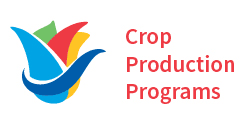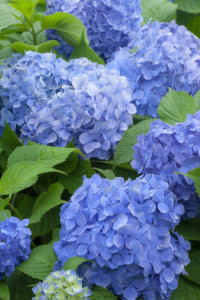
Hydrangea Fertilizer Tips & Program
For the production of hydrangeas (also called hortensia) start with a media that provides good drainage, while maintaining a high water-holding capacity. The ideal starting soil temperature is around 16° C, while air temperature should be slightly cooler at 14-16° C. Monitoring pH and salts level is very important. The pH of blue hydrangea should be 4.8 – 5.4 and salts no higher than 1.2.
For pink hydrangea, pH should be above 6.0 and salts around 1.5. Flower production is achieved by the forcing of plant
development, which is directly related to daily temperature. Plants can be forced in 80-100 days using 16° C nights and 21° C cloudyday/24° C sunny day temperatures until flowers begin to develop and show colour. Once colouration begins, temperature should be dropped to 12° C night and 18° C day to intensify flower colour. Avoid excessively warm temperatures during forcing to reduce the occurrence of small plants, small inflorescences, less intense colouration, and a poor quality plant.
Most hydrangea cultivars require height control during forcing. First applications of grow retardant (B-nine) should be made when 3-5 leaf pairs begin to unfold (2-4 weeks after the start of forcing). Under poor light conditions, repeat applications at 10-14 day intervals. Treatment should be discontinued prior to flower buds reaching ¾” in diameter.
Hydrangea Fertilizer should not be applied until root activity and transplanting have occurred. Start with one application of Plant-Prod® 10-52-10 Starter or Plant-Prod 20-20-20 All Purpose. The presence and availability of aluminum determines the colour of flowers in certain cultivars of hydrangeas with pigments. Those without pigments maintain white flowers. The absence of aluminum leads to pink flowers, while high availability of aluminum results in blue flowers. The availability of aluminum is greater in soils with low pH.
For growing pink Hydrangea, start with Plant-Prod Solutions® 17-5-17 Complete at 100-200 ppm nitrogen. Every third feeding, apply Plant-Prod 15-30-15 High Phosphate at the same rate. The high phosphorus will tie up excess aluminum in the soil, resulting in a strong pink colouration in the blooms.
For growing blue hydrangeas, start with two feedings of 100 g of Plant-Prod 20-0-20 Hydrangea with 1.3 g iron EDTA chelate in 100 L of water to provide a rate of 200 ppm nitrogen. This should be followed by a single feeding of 100 g of Plant-Prod 20-2-20 Acidic High Nitrate and 1.3 g iron EDTA chelate in 100 L of water. Ensure to monitor pH throughout production. If pH goes to 4.7 – 4.8, Plant-Prod 12-0-44 Finisher should be used alone. If salts are higher than 1.2, irrigate with clear water. The application of aluminum sulphate is recommended when flower buds are very small. This should be applied 3-4 times at 7 day intervals at a rate of 1 kg in 100 L of water.
Hydrangea Fertilizer should be reduced by half at the start of flower colouration in order to harden off plants. Shading to prevent overheating is beneficial during the last few weeks of production. Desirable temperature during this period is between 13-15° C. Watering should be slowly reduced, but plants should not be allowed to wilt as they will never fully recover.

- Plant-Prod 10-52-10 Starter Water Soluble Fertilizer
- Plant-Prod 12-0-44 Finisher Water Soluble Fertilizer
- Plant-Prod 15-30-15 High P Water Soluble Fertilizer
- Plant-Prod 20-0-20 Hydrangea Water Soluble Fertilizer
- Plant-Prod 20-2-20 Acidic High Nitrate Water Soluble Fertilizer
- Plant-Prod 20-20-20 Classic Water Soluble Fertilizer
- Plant-Prod Solutions 17-5-17 Complete Water Soluble Fertilizer

